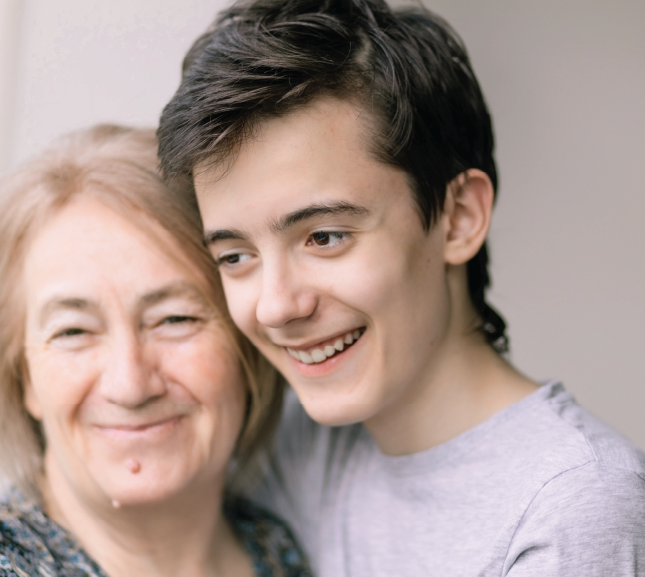Let’s talk about invisible disabilities
April 11, 2024
When you think of the word, ‘disability’ what do you see? Perhaps you envision someone in a wheelchair, or a person walking with a cane. The reality is that for 90% of people living with a disability in Australia, their disability is invisible. Here, one of our Coordinators Julian Baez Avellaneda shares the ins and outs of invisible disabilities and how you can best support friends, colleagues and family members living with disabilities that are hidden from plain sight.
What is an invisible disability?
The term invisible disability refers to disabling factors people might live with that impact them in ways that aren’t physically noticeable to other people. For example, a person with Down Syndrome may have an intellectual disability, and likewise you have people with autism who may also have an intellectual disability. While Down Syndrome is a condition where a person has an extra chromosome and you can typically see that they might have a disability by looking at them due to a distinct facial appearance, for someone with autism who may also find it difficult to live what is considered a mainstream life without support, you most likely would never know this by looking at them.
People with autism often give an impression to those around them that they are quite independent, but there comes a point where that independence can wane, and they struggle. Often, no one understands why they are struggling, because the don’t appear ‘disabled’, which can attract judgement and criticism.
What are some examples of invisible disabilities?
Mental health conditions, learning disabilities, traumatic brain injury, diabetes, cystic fibrosis, chronic pain, epilepsy, deafness, visual impairment, multiple sclerosis, autism and Attention Deficit Hyperactivity Disorder (ADHD) are all examples of invisible disabilities. And there are many more.
What are some of the challenges for people living with an invisible disability?
For people living with an invisible disability, their behaviour often gets mislabelled as lazy, antisocial or weak. It is not obvious that there is another factor at play driving the behaviour. Often, the person ends up being defined by their behaviour, for example, “the lazy guy” or “the guy that doesn’t know when to stop talking, or can’t make eye contact”, says Julian.
There is also the common quandary of whether to be upfront about their disability. If they mention their disability, say in a job interview, there is a real risk that their job prospects will be limited. But on the flip side, they know that they need to mention their disability to get the support they need to carry out the job. Knowing that highlighting their disability will bring a lot of problems, they often end up falling through the cracks.
Another challenge is getting the right support. Often people with invisible disabilities turn up to NDIS meetings looking very independent, and don’t get the funding they need unless they can articulately explain the impact of their disability. Compare this to someone who shows up at an NDIS meeting in a wheelchair where their support needs are more obvious.
How can I best support friends, colleagues and family members living with an invisible disability?
Julian’s advice is to get to know the individual and understand what that person specifically needs to live a fulfilled life. For this to be meaningful, a relationship needs to be established, and this is what workplaces need to do more of. Managers need to work to build genuine relationships with employees so that support needs can be met.
If you have close friends and family members living with an invisible disability, you may suggest that they apply for an Invisible Disability Access Card and lanyard. This is worn when in public to explain the assistance that they may need.
As a society we always need to look for the underlying factors behind behaviours and never make assumptions. The best approach when faced with a challenging behaviour is to explore the reason for it in a non-judgmental way. A challenging behaviour might be an indication of a person’s needs in that moment, and it is up to us to empathise and respond.
For more information about CatholicCare’s disability and NDIS supports visit our website, email info@catholiccaredbb.org.au or call us today on 1800 324 924.
More news stories like this one
Empowering through skills – our Clarke Road disability hub launches innovative new programs
Over the past five months we've revamped and launched several new programs at or Clarke Road disability hub, each one focused on learning, independence and empowerment.
Read MoreBunnies, eggs and fasting – we answer some of your Easter questions
Every year, once Christmas is over, the Easter bunnies, eggs and hot cross buns seem to enter shopping centres earlier and earlier. These symbols of Easter are so entrenched in our culture that we don’t often think to ask where they originated.
Read MoreOscar’s search for family takes him to NZ
From a young age, Oscar wondered about his estranged family, but these thoughts were often associated with sadness. After entering care with CatholicCare in 2019, his team of workers became his substitute family.
Read More


